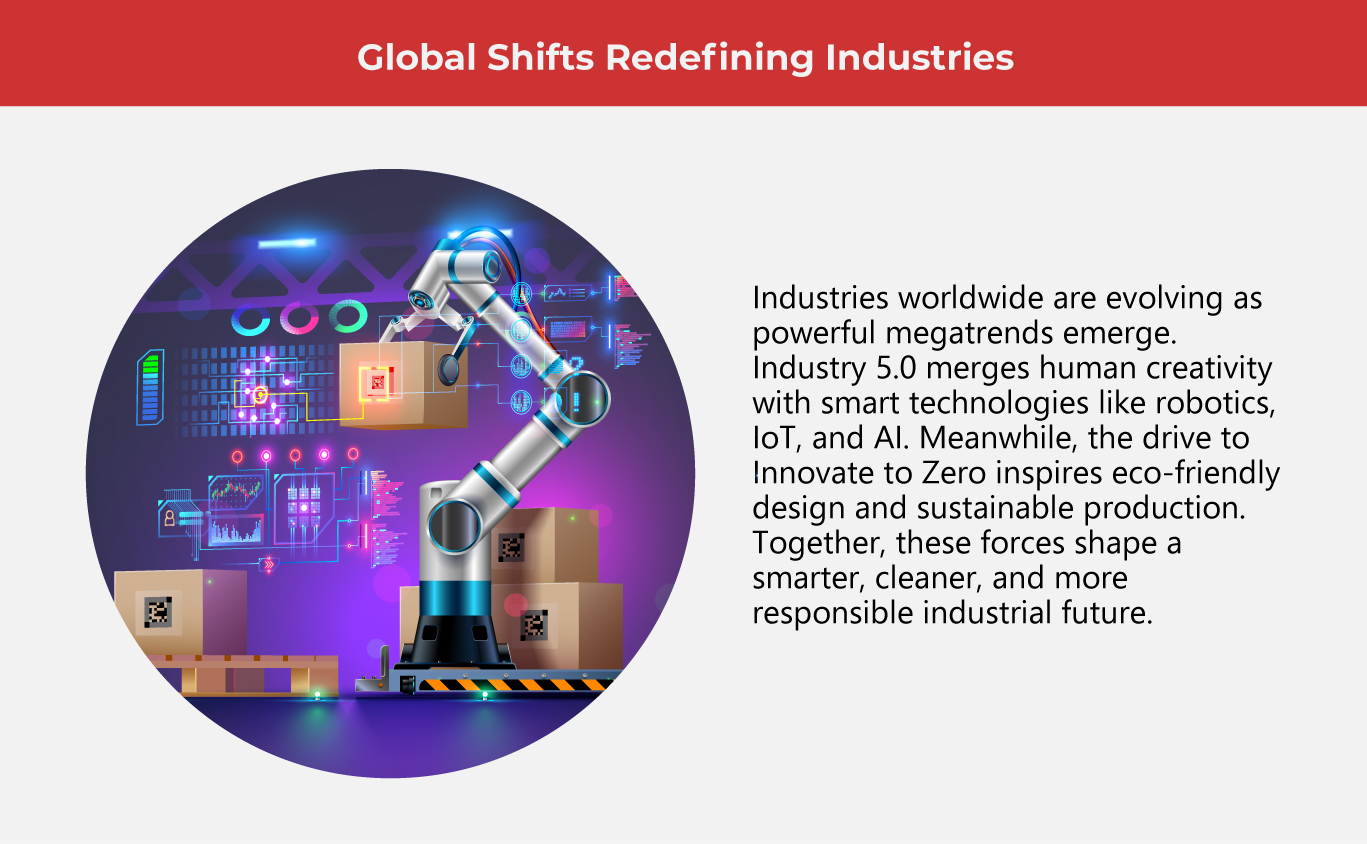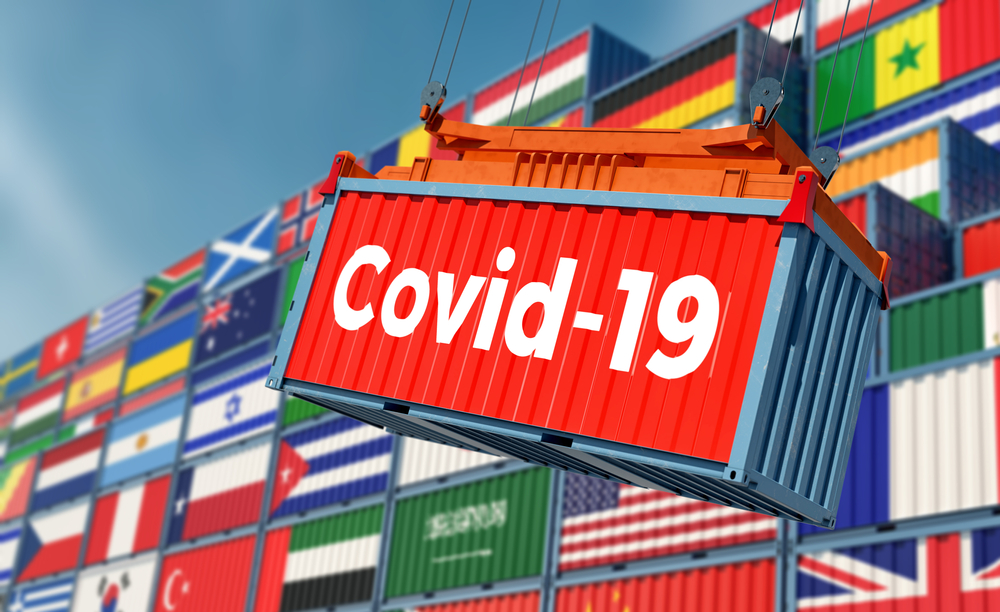Top 10 Manufacturing Trends You Shouldn’t Ignore

Global manufacturing is being transformed by powerful megatrends that extend beyond technology. Industry 5.0, automation, and sustainable innovation are redefining production, while workforce evolution and regionalized supply chain management are reshaping global competitiveness.
According to Deloitte’s 2024 Manufacturing Outlook, 98% of manufacturers have begun their digital transformation journey, up from 78% in 2019. The consulting organization also projects 3.8 million net new manufacturing jobs globally between 2024 and 2033, underscoring how the future-ready manufacturing sector is not just revolutionizing factories—they’re reshaping the future of work and the broader industrial market.
The global megatrends outlined below highlight the powerful forces reshaping manufacturing industries, communities, and innovation ecosystems. Acting as a strategic guide, these trends enable industry professionals and decision-makers to anticipate long-term shifts, respond to emerging challenges, and strengthen their position for sustainable growth and future success.
1. Supply chain shifts
Global supply chains are being redefined as manufacturers shift toward regional production. Instead of relying on distant suppliers, more companies are turning to nearby sources to limit disruptions from pandemics, trade disputes, or extreme weather. Governments are reinforcing this shift through tax incentives, while AI-powered logistics are making regional operations faster and more reliable. For manufacturing markets, this move signals a lasting transformation—one where proximity, flexibility, and resilience increasingly outweigh cost as the key drivers of competitive advantage.
2. Demographic transformation
By 2030, the global population is expected to reach 8.5 billion, transforming labor markets and consumer demand. Nearly two-thirds of people will live in cities that together generate 80% of global GDP, driving demand for infrastructure, transport, and goods. While developed nations such as Japan and Spain face aging and shrinking populations, emerging megacities like Shanghai, Mumbai, and Lagos will anchor industrial growth. The rise of more than one billion people aged over 65 will also steer manufacturing toward automation, healthcare, and adaptive manufacturing solutions.
3. Climate change management
As global emissions surpass 37.7 billion tonnes, manufacturers face growing pressure to cut carbon and align operations with sustainability goals. This is driving major investments in the renewable energy market, carbon capture, and circular production models, moving industries toward climate-positive growth. Green and sustainable bond issuance is projected to reach $1 trillion annually, supporting clean technology and energy-efficient innovation. Companies such as Google and IKEA are leading this shift through carbon-free commitments. Managing climate impact is now central to the competitiveness of manufacturing.
4. Sustainability as a competitive edge
Sustainability is becoming a powerful driver of competitiveness in manufacturing. Buyers now consider environmental indicators alongside price and delivery, evaluating how products and processes affect the planet. Carbon reporting rules, border taxes, and ESG standards are transforming procurement practices, rewarding manufacturers that minimize emissions and resource use. Products with verified low-carbon and eco-efficient profiles are gaining preference and sometimes exclusive access to bids. Companies that embed transparent environmental data into proposals and operations will stay ahead in a greening global economy.
5. Circular innovation
Intensifying population growth and environmental stress are tightening global supplies of energy, water, and raw materials. As demand rises, manufacturers must rethink how resources are sourced, used, and recovered. Extending the product life profile—from design to reuse—has become vital to conserving materials and cutting waste. Climate change and commodity volatility are accelerating the move toward circular systems and sustainable production. Companies that design for durability, recyclability, and efficiency will not only reduce dependence on scarce inputs but also secure long-term competitiveness.
6. Agile production
Automation is transforming modern manufacturing as robotics, AI-based scheduling, and modular production systems make real-time reconfiguration possible. By 2030, adaptability will distinguish industry leaders, enabling swift shifts in product development, scale, and delivery. Smart factories using data analytics, machine learning, and connected systems are evolving from fixed to flexible operations. Even partial automation boosts efficiency, minimizes downtime, and enhances customization. Manufacturers that embrace automation early will achieve faster response times, greater productivity, and stronger resilience in an increasingly dynamic and technology-driven marketplace.
(Also read: Why You Should Invest in Machine Vision)
7. Next-generation mobility
The automotive market is undergoing a profound shift as electrification, automation, and connectivity redefine transportation. Global electric vehicle sales are projected to exceed 20 million in 2025, reflecting growing demand for cleaner, smarter mobility. Advances in AI, battery efficiency, and data-driven infrastructure are transforming how people and goods travel. Shared and intelligent transport systems are easing congestion, cutting emissions, and improving accessibility. As sustainability and technology converge, the industry is moving toward a mobility landscape that is more efficient, inclusive, and environmentally conscious.
8. Emerging engines of growth
Global economic power is moving eastward as developing markets rise and redefine trade dynamics. Within two decades, the combined GDP of China, India, Brazil, and other Emerging Seven nations is projected to exceed that of the G7. Asia-Pacific’s rapidly expanding middle class will account for most global consumption by 2030, reshaping demand across industries. Strengthened by digital connectivity and large-scale infrastructure, the region’s expanding economic value is redefining where growth originates and urging manufacturers to rebalance strategies toward an Asia-centered global economy.
9. Redefining Well-Being
Health and wellness are being transformed by medical electronics, digital platforms, and growing health awareness. Care is shifting from reactive to proactive as wearable sensors, telehealth systems, and smart diagnostics enable continuous, personalized monitoring. The wellness economy is expected to reach $9 trillion by 2028, reflecting rising demand for preventive and data-driven solutions. Advances in biotechnology and mental health technologies are expanding access to holistic care. For manufacturers, the integration of medical electronics presents new opportunities to enhance the quality of life.
(Also read: Top 8 Advancements that Boost Battlefield Healthcare)
10. Urbanization
Urban life is expanding rapidly, with nearly 70% of the world’s population expected to live in cities by 2050. This shift is fueling a global push for smarter, greener, and more inclusive urban spaces. Bridging a projected $15 trillion infrastructure gap requires innovation in construction, mobility, and sustainability. From smart transport systems to energy-efficient buildings and digital connectivity, cities are being redesigned to enhance both livability and opportunity. For businesses and communities alike, shaping resilient, people-centered cities will define the next chapter of sustainable growth.

Shaping the future
As industries navigate a rapidly evolving landscape, success will depend on foresight, adaptability, and purpose. Businesses that embed sustainability into strategy, embrace digital transformation, and cater to shifting demographics will secure lasting relevance. Building agile operations and ethical, inclusive cultures strengthens resilience in an unpredictable global economy.
Future-readiness demands continuous innovation, smarter technologies, and a deep understanding of emerging markets. Companies must rethink products, refine talent strategies, and adopt comprehensive risk management to stay ahead. The decisions made today will define how industries not only endure but thrive in the dynamic decade leading to 2030.
As one of the Top 20 EMS companies in the world, IMI has over 40 years of experience in providing electronics manufacturing and technology solutions.
We are ready to support your business on a global scale.
Our proven technical expertise, worldwide reach, and vast experience in high-growth and emerging markets make us the ideal global manufacturing solutions partner.
Let's work together to build our future today.




